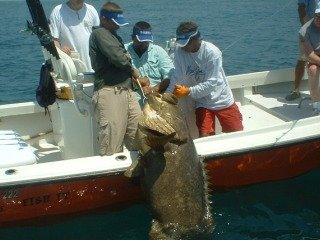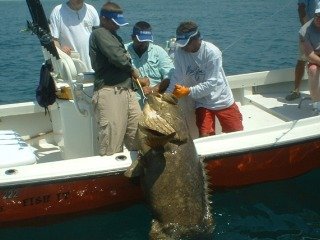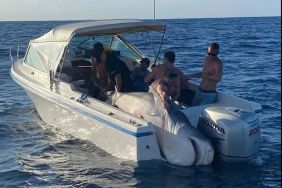 Lurking in the deepest recesses of inshore waters is one of the most powerful and challenging species sought by anglers. It can reach lengths of eight feet and can weigh as much as 800 pounds. With nearly no natural predators once adulthood is reached and with a history of even stalking human swimmers on occasion, this monster of the deep is truly a worthy adversary for any fisherman. What kind of fish could possess such beastly characteristics, you ask? No, it’s not a shark, or an alligator gar; it’s the Goliath Grouper.
Lurking in the deepest recesses of inshore waters is one of the most powerful and challenging species sought by anglers. It can reach lengths of eight feet and can weigh as much as 800 pounds. With nearly no natural predators once adulthood is reached and with a history of even stalking human swimmers on occasion, this monster of the deep is truly a worthy adversary for any fisherman. What kind of fish could possess such beastly characteristics, you ask? No, it’s not a shark, or an alligator gar; it’s the Goliath Grouper.
Yes, the Goliath Grouper looks just as its name implies: enormous! In fact, the largest recorded Goliath Grouper caught on hook and line weighed in at a massive 680 pounds! The grouper as a species closely resembles freshwater bass in body style. The grouper stalks the waters of the Atlantic, ranging from Florida all the way to Brazil, the Pacific from the Gulf of California to Peru, and can even be found in the coastal waters of the eastern Atlantic, along Africa’s west coast. It can also be found in brackish waters.
Goliath Groupers feed primarily on crustaceans such as spiny lobsters, shrimp, and crabs, as well as stingrays, octopi, and even young sea turtles, all of which it can easily catch and devour with its three to five rows of teeth. These teeth are more than capable of seizing and gripping prey items, though most of the grouper’s food is swallowed whole. The only predators of the Goliath Grouper include sharks, barracuda, and moray eels, all of which are only a threat to young groupers.
Popular locations to fish for Goliath Grouper include bridges and structure when angling inshore, and sunken wrecks and reefs offshore. The best way to fish for these monsters is with heavy tackle and live bait such as ribbon fish or even small stingrays. They’re bottom feeders so jig your bait just off the bottom and hold on tight once you get a strike. Goliaths tend to retreat back to their hiding spots once hooked, which can make for very, very long fights. If you’re not prepared for the fight that will ensue, you may wind up going for a swim. The easily approachable nature of the grouper makes it a great fish for spear fishermen, though this has reduced its population in areas accessible to divers. Be sure to research the regulations on Goliaths in your area, as they are protected by law in many areas. The last thing you want is a fine and punishment for poaching.
Catching a Goliath Grouper is a true test of you endurance, willpower, and strength. It is a full contact sport that can leave even the strongest and fittest of anglers exhausted only minutes into the fight. However, if you’re truly dedicated to muscling one of these mammoths to the boat, and you can endure the long and demanding battle of catching one, you’ll be rewarded with a prize like no other. Be sure to take lots of pictures, because you’ll definitely want proof to back up your story when regaling your jealous friends with your tale of triumph.








